Simulating the Response of Estuarine Salinity to Natural and Anthropogenic Controls
Abstract
:1. Introduction
2. Materials and Methods
2.1. Observed Data for Model Validation
2.2. The Integrated Modeling System—Description and Setup
2.3. River Flow Scenarios
3. Results
3.1. Model Verification—Salinity during 2004
3.2. Model Results for the 1999–2008 Period
Impact of River Flow Scenarios on Bay Salinity
3.3. Effects of Potential Sea Level Rise on Bay Salinity
4. Discussion
- Apalachicola Bay salinity regime can quickly recover from extreme events such as hurricanes.
- Scenario I (observed) is more likely to create favorable conditions for oyster production.
- Scenarios II–IV, corresponding to higher (~1%) consumptive freshwater demand than in the observed scenario, are likely to result in slightly (~5%) higher salinities and unfavorable conditions for oyster production.
- Newer freshwater flow alternatives which may cause more significant changes to the bay salinity are being developed by the Corps.
- The worst case sea level rise scenario (~1 m by 2100) could significantly increase the bay salinity by up to 20%.
Acknowledgments
Author Contributions
Conflicts of Interest
References
- US Army Corps of Engineers. 2015 ACF Water Control Manual Update and Draft Environmental Impact Statement. Available online: http://www.sam.usace.army.mil/Missions/Planning-Environmental/ACF-Master-Water-Control-Manual-Update/ACF-Document-Library/ (accessed on 15 September 2016).
- US Fish and Wildlife Service. Biological Opinion. Endangered Species Act Section 7 Consultation on the U.S. Army Corps of Engineers Mobile District Update of the Water Control Manual for the Apalachicola-Chattahoochee-Flint River Basin in Alabama, Florida, and Georgia and a Water Supply Storage Assessment; USFWS Log No: 04EF3000-2016-F-0181; U.S. Fish and Wildlife Service Panama City Field Office: Panama City, FL, USA, 2016.
- Huang, W.; Hagen, S.; Bacopoulos, P.; Wang, D. Hydrodynamic modeling and analysis of sea-level rise impacts on salinity for oyster growth in Apalachicola Bay, Florida. Estuar. Coast. Shelf Sci. 2015, 156, 7–18. [Google Scholar] [CrossRef]
- Huang, W.; Hagen, S.C.; Bacopoulos, P.; Teng, F. Sea-Level Rise Impacts on Hurricane-Induced Salinity Transport in Apalachicola Bay. J. Coast. Res. 2014, 68, 49–56. [Google Scholar] [CrossRef]
- Huang, W.; Spaulding, M. Modelling residence time response to freshwater input in Apalachicola Bay, Florida, USA. Hydrol. Process. 2002, 16, 3051–3064. [Google Scholar] [CrossRef]
- Edminston, H.L. A River Meets the Bay: A Characterization of the Apalachicola River and Bay System; Apalachicola National Estuarine Research Reserve: Eastpoint, FL, USA, 2008. [Google Scholar]
- Florida Department of Environmental Protection (FDEP); Apalachicola National Estuarine Research Reserve. Management Plan. October 2011. Available online: http://publicfiles.dep.state.fl.us/cama/plans/aquatic/ANERR_Management_Plan_2013.pdf (accessed on 14 November 2016).
- Livingston, R.J.; Lewis, F.G.; Woodsum, G.C.; Niu, X.-F.; Galperin, B.; Huang, W.; Christensen, J.D.; Monaco, M.E.; Battista, T.A.; Klein, C.J.; et al. Modeling oyster population response to freshwater inputs. Estuar. Coast. Shelf Sci. 2000, 50, 655–672. [Google Scholar] [CrossRef]
- Altinok, I.; Grizzle, J.M. Effects of brackish water on growth, feed conversion and energy absorption efficiency by juvenile euryhaline and freshwater stenohaline fishes. J. Fish Biol. 2001, 59, 1142–1152. [Google Scholar] [CrossRef]
- United States Fish and Wildlife Service (USFWS). Biological Opinion on the U.S. Army Corps of Engineers, Mobile District, Revised Interim Operating Plan for Jim Woodruff Dam and the Associated Releases to the Apalachicola River; U.S. Fish and Wildlife Service, Panama City Field Office: Panama City, FL, USA, 2008; p. 225.
- Sulak, K.J.; Randall, M.T.; Edwards, R.E.; Summers, T.M.; Luke, K.E.; Smith, W.T.; Norem, A.D.; Harden, W.M.; Lukens, R.H.; Parauka, F.; et al. Defining winter trophic habitat of juvenile Gulf sturgeon in the Suwannee and Apalachicola rivermouth estuaries, acoustic telemetry investigations. J. Appl. Ichthyol. 2009, 25, 505–515. [Google Scholar] [CrossRef]
- Randall, M.T.; Sulak, K.J. Relationship between recruitment of Gulf sturgeon, Acipenser oxyrinchus desotoi, and water flow in the Suwannee River, Florida. In Proceedings of the Anadromous Sturgeon Symposium, Quebec City, QC, Canada, 11–13 August 2003.
- Huang, W. Hydrodynamic modeling and ecohydrological analysis of river inflow effects on Apalachicola Bay, Florida, USA. Estuar. Coast. Shelf Sci. 2010, 86, 526–534. [Google Scholar] [CrossRef]
- Huang, W.; Jones, W.K.; Wu, T.S. Modelling wind effects on subtidal salinity in Apalachicola Bay, Florida. Estuar. Coast. Shelf Sci. 2002, 55, 33–46. [Google Scholar] [CrossRef]
- Wang, H.; Huang, W.; Harwell, M.A.; Edmiston, L.; Johnson, E.; Hsieh, P.; Milla, K.; Christensen, J.; Stewart, J.; Liu, X. Modeling oyster growth rate by coupling oyster population and hydrodynamic models for Apalachicola Bay, Florida, USA. Ecol. Model. 2008, 211, 77–89. [Google Scholar] [CrossRef]
- Sheng, Y.P. Evolution of a Three-Dimensional Curvilinear-Grid Hydrodynamic Model for Estuaries, Lakes and Coastal Waters: CH3D. In Estuarine and Coastal Modeling, Proceedings of the Estuarine and Coastal Circulation and Pollution Transport Model Data Comparison Specialty Conference, Newport, RI, USA, 15–17 November 1989; American Society of Civil Engineers: New York, NY, USA, 1990; pp. 40–49. [Google Scholar]
- Sheng, Y.P.; Paramygin, V.A.; Zhang, Y.; Davis, J.R. Recent enhancements and application of an integrated storm surge modeling system: CH3D-SSMS. In Proceedings of the Tenth International Conference on Estuarine and Coastal Modeling, Newport, RI, USA, 5–7 November 2007; pp. 879–892.
- Sheng, Y.P.; Kim, T. Skill assessment of an integrated modeling system for shallow estuarine and coastal ecosystems. J. Mar. Syst. 2009, 76, 212–243. [Google Scholar] [CrossRef]
- Klipsh, J.D.; Hurst, M.B. HEC-ResSim Reservoir System Simulation User’s Manual, Version 3; US Army Corps of Engineers: Washington, DC, USA, 2007. [Google Scholar]
- Sheng, Y.P. On modeling three-dimensional estuarine and marine hydrodynamics. In Three-Dimensional Marine and Estuarine Hydrodynamics; Nihoul, J.C., Jamart, B.M., Eds.; Elsevier: Amsterdam, The Netherlands, 1987; pp. 35–54. [Google Scholar]
- Sheng, Y.P. A framework for integrated modeling of hydrodynamic, sedimentary, and water quality processes. Estuar. Coast. Model. 2000, 6, 350–362. [Google Scholar]
- Sheng, Y.P.; Davis, J.R.; Sun, D.; Qiu, C.; Park, K.; Kim, T.; Zhang, Y. Application of an integrated modeling system for estuarine and coastal ecosystems to Indian River Lagoon, Florida. Estuar. Coast. Model. 2002, 7, 329–343. [Google Scholar]
- Kim, T.; Sheng, Y.P.; Park, K. Modelling water quality and hypoxia dynamics in Upper Charlotte Harbor, Florida, U.S.A. during 2000. Estuar. Coast. Shelf Sci. 2010, 90, 250–263. [Google Scholar] [CrossRef]
- Sheng, Y.P. An Integrated Modeling System for Forecasting the Response of Estuarine and Coastal Ecosystems to Anthropogenic and Climate Changes. In Ecological Forecasting: New Tools for Coastal and Marine Ecosystem Management; Valette-Silver, N., Scavia, D., Eds.; NOAA Technical Memorandum NOS NCCOS 1; 2003; pp. 203–210. Available online: http://oceanservice.noaa.gov/topics/coasts/ecoforecasting/ecoforecast.pdf (accessed on 14 November 2016). [Google Scholar]
- Sheng, Y.P.; Paramygin, V.A.; Alymov, V.; Davis, J.R. A Real-Time Forecasting System for Hurricane Induced Storm Surge and Coastal Flooding. In Proceedings of the Ninth International Conference on Estuarine and Coastal Modeling, Charleston, SC, USA, 2 September–31 October 2005; pp. 585–602.
- Sheng, Y.P.; Alymov, V.; Paramygin, V.A. Simulation of storm surge, waves, and inundation in the Outer Banks and Chesapeake Bay during Hurricane Isabel in 2003: The importance of waves. J. Geophys. Res. 2010, 115. [Google Scholar] [CrossRef]
- Sheng, Y.P.; Zhang, Y.; Paramygin, V.A. Simulation of Storm Surge, Wave, and Coastal Inundation during Hurricane Ivan in 2004. Ocean Model. 2010, 35, 314–331. [Google Scholar] [CrossRef]
- Sheng, Y.P.; Villaret, C. Modeling the effect of suspended sediment stratification on bottom exchange process. J. Geophys. Res. 1989, 94, 14229–14444. [Google Scholar] [CrossRef]
- Sheng, Y.P.; Liu, T. Three-dimensional simulation of wave-induced circulation: Comparison of three radiation stress formulations. J. Geophys. Res. 2011, 116, C05021. [Google Scholar] [CrossRef]
- Bleck, R. An oceanic general circulation model framed in hybrid isopycniccartesian coordinates. Ocean Model. 2002, 4, 55–88. [Google Scholar] [CrossRef]
- Chassignet, E.P.; Hurlburt, H.E.; Smedstad, O.M.; Halliwell, G.R.; Hogan, P.J.; Wallcraft, A.J.; Baraille, R.; Bleck, R. The HYCOM (HYbrid Coordinate Ocean Model) data assimilative system. J. Mar. Syst. 2007, 65, 60–83. [Google Scholar] [CrossRef]
- Rosmond, T.E. The Design and Testing of the Navy Operational Global Atmospheric Prediction System. Weather Forecast. 1992, 7, 262–272. [Google Scholar] [CrossRef]
- Light, H.M.; Vincent, K.R.; Darst, M.R.; Price, F.D. Water-Level Decline in the Apalachicola River, Florida, from 1954 to 2004, and Effects on Floodplain Habitats; U.S. Geological Survey Scientific Investigations Report 2006-5173; U.S. Geological Survey: Reston, VA, USA, 2006.
- Leitman, S.; UF Water Institute, Gainesville, FL, USA. An explanation of the problems with flow data from the sumatra gauge. Personal communication, 2016. [Google Scholar]
- Tutak, B.; Sheng, Y.P. Effect of tropical cyclones on residual circulation and momentum balance in a subtropical estuary and inlet: Observation and simulation. J. Geophys. Res. 2011, 116, C06014. [Google Scholar] [CrossRef]
- Intergovernmental Panel on Climate Change (IPCC). Climate Change 2013: The Physical Science Basis Working Group I Contribution to the Fifth Assessment Report of the Intergovernmental Panel on Climate Change; Cambridge University Press: Cambridge, UK; New York, NY, USA, 2013; Available online: http://www.ipcc.ch/report/ar5/wg1/ (accessed on 10 May 2016).
- Davis, H.C.; Calabrese, A. Combined effects of temperature and salinity on development of eggs and growth of larve of M. Mercenaria and C. Virginica. Fish. Bull. 1964, 63, 643–655. [Google Scholar]
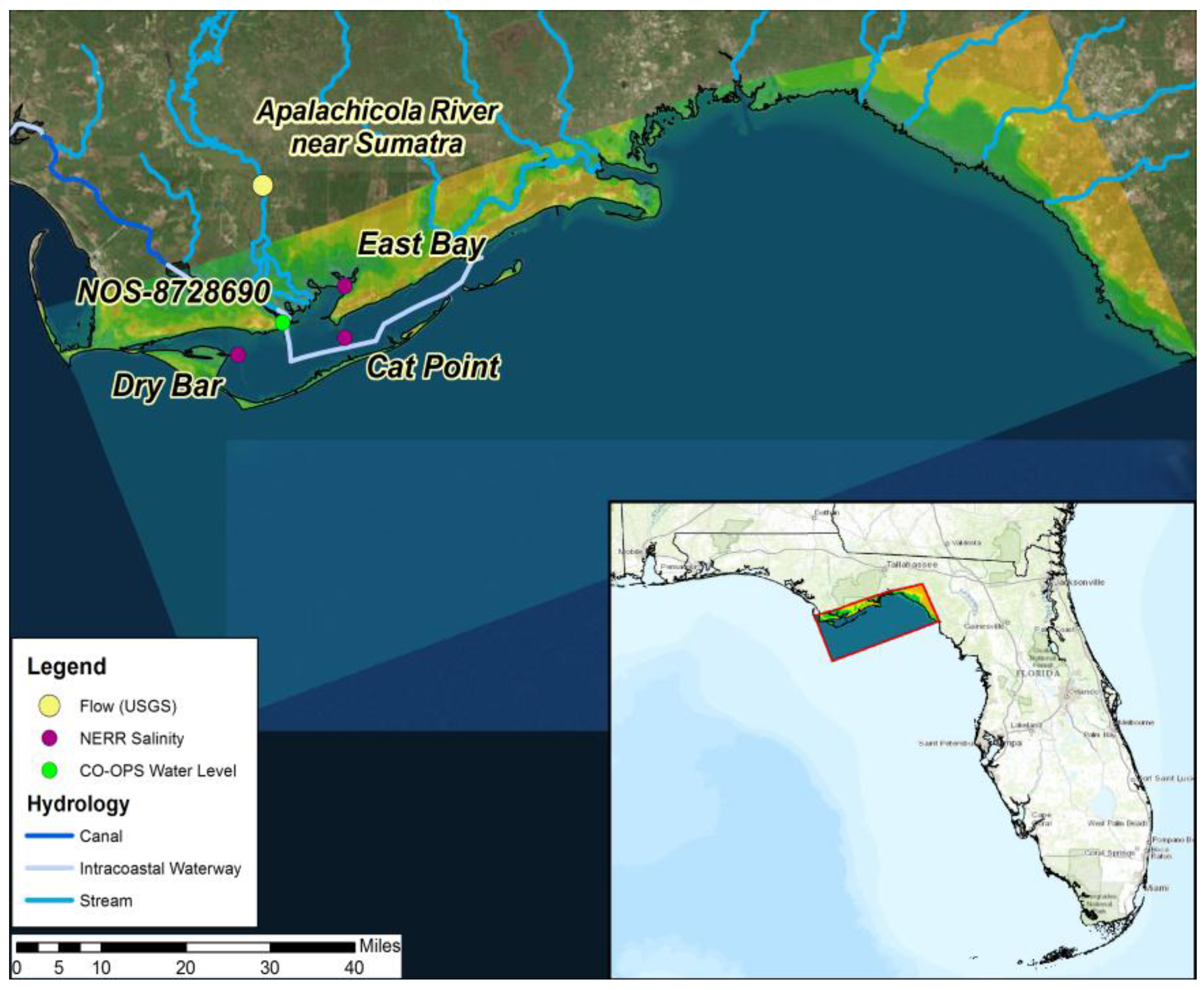
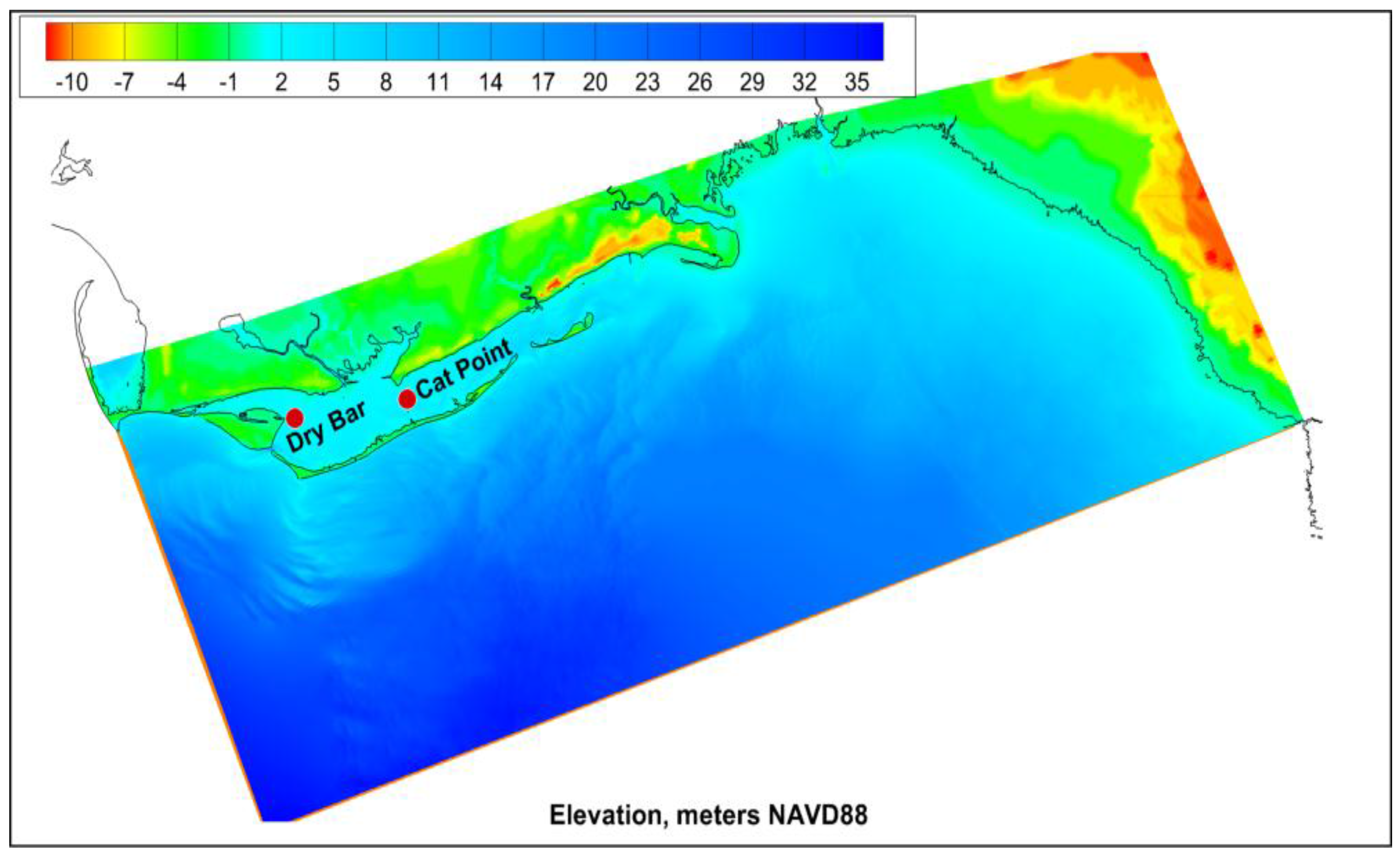
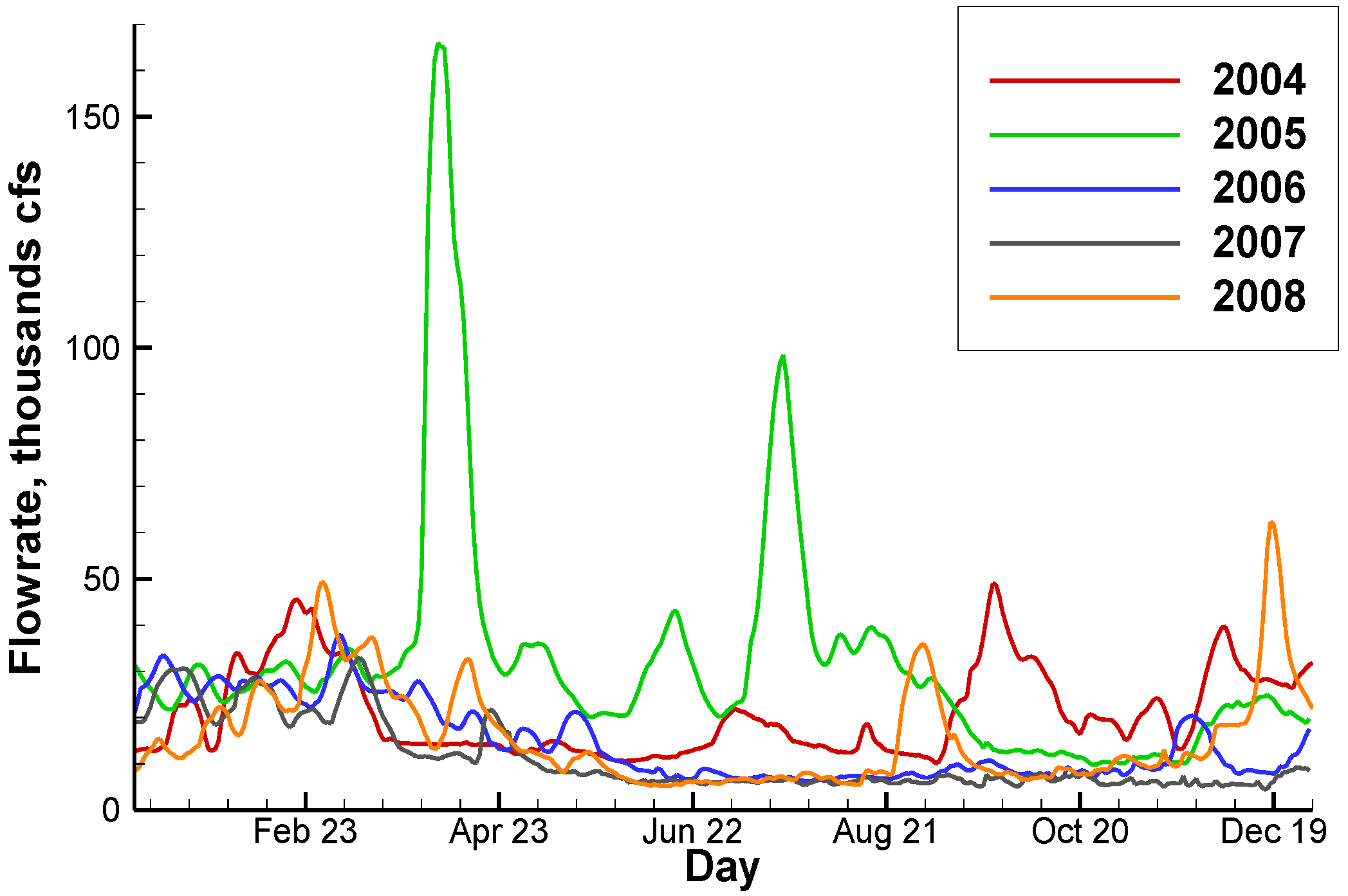

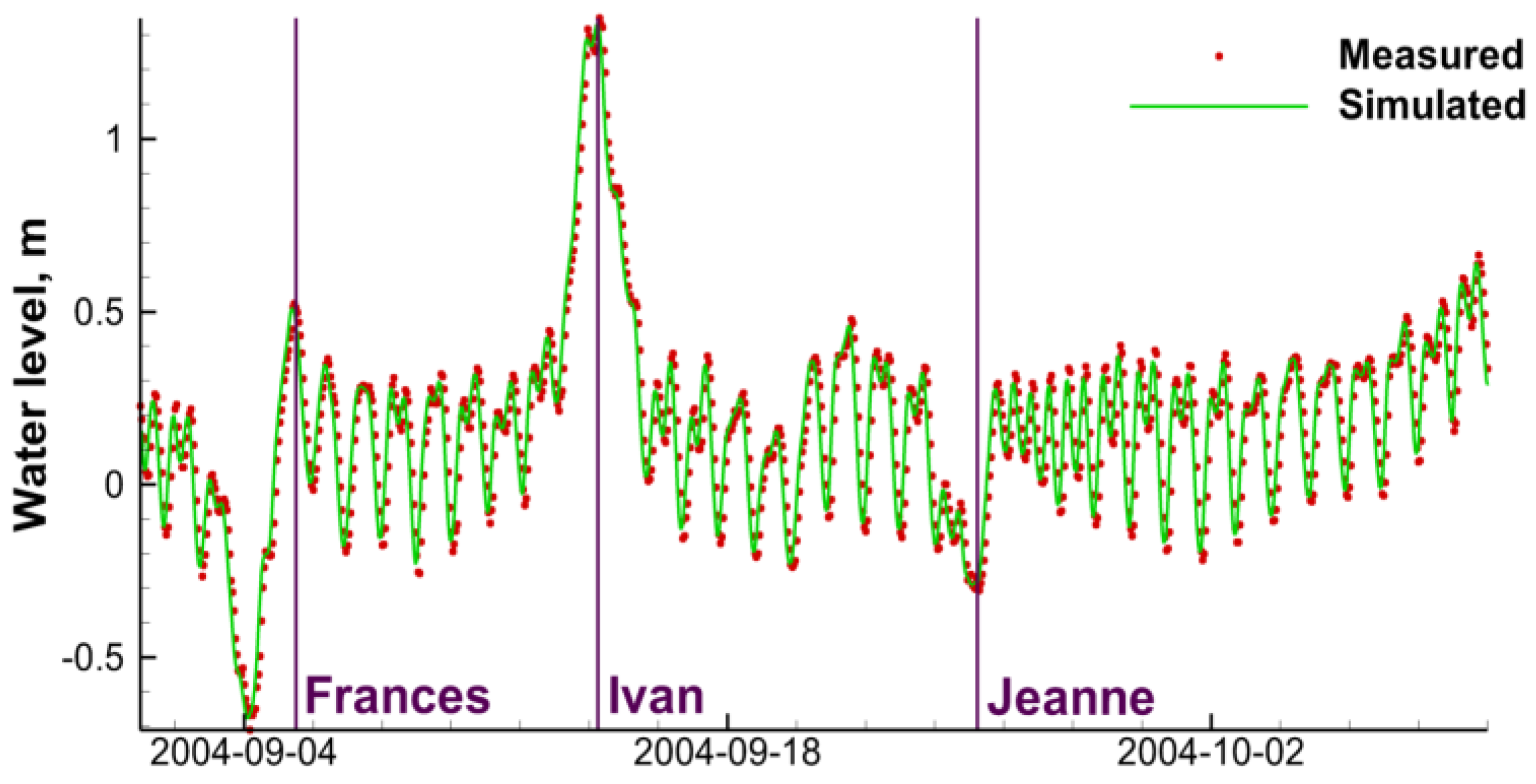
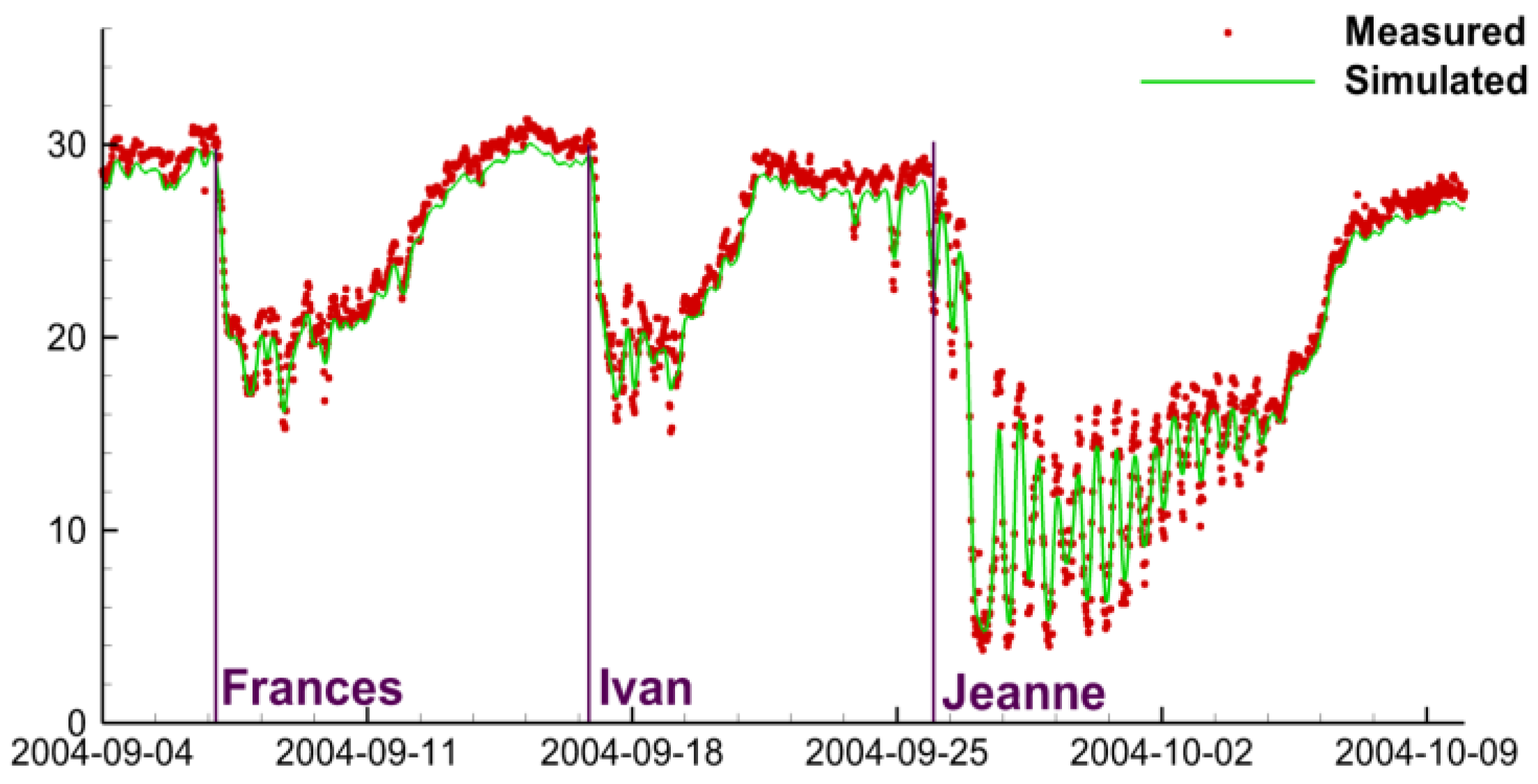


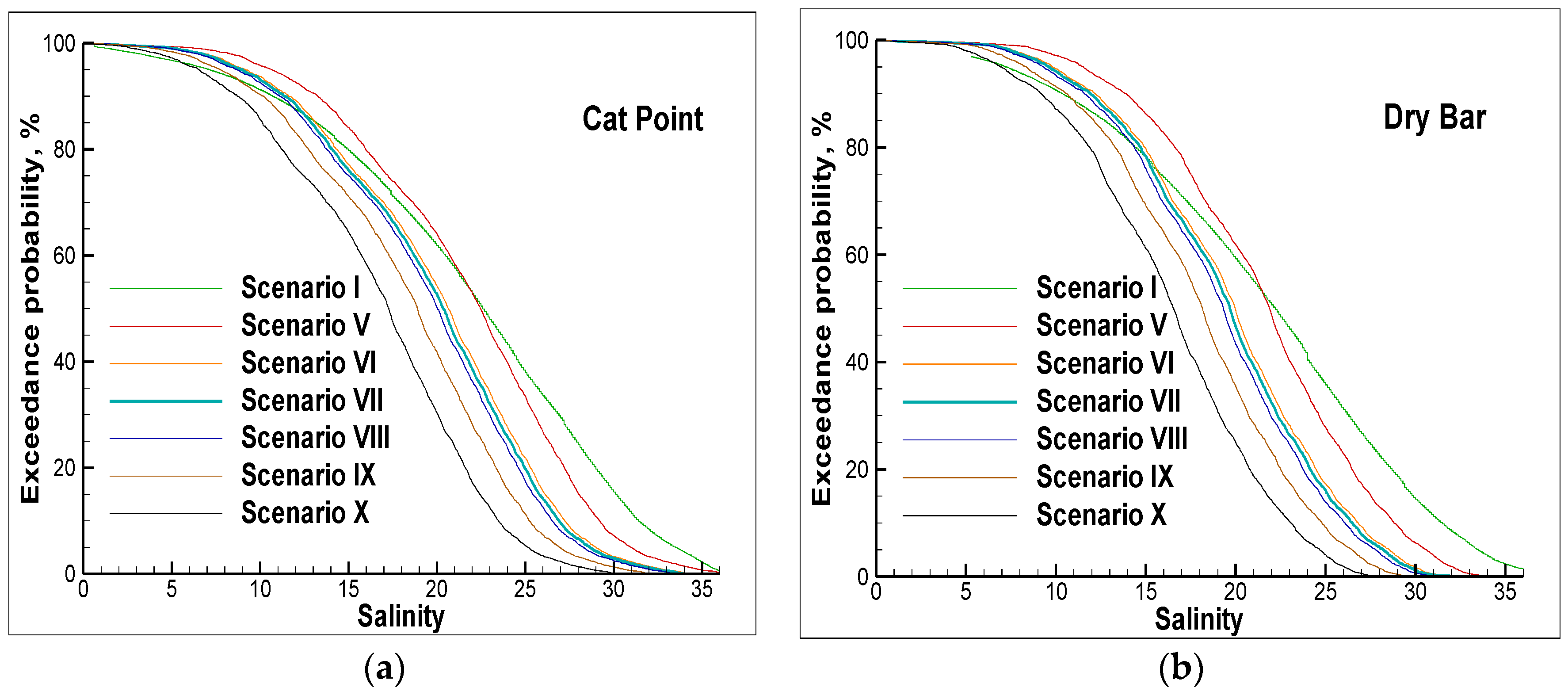
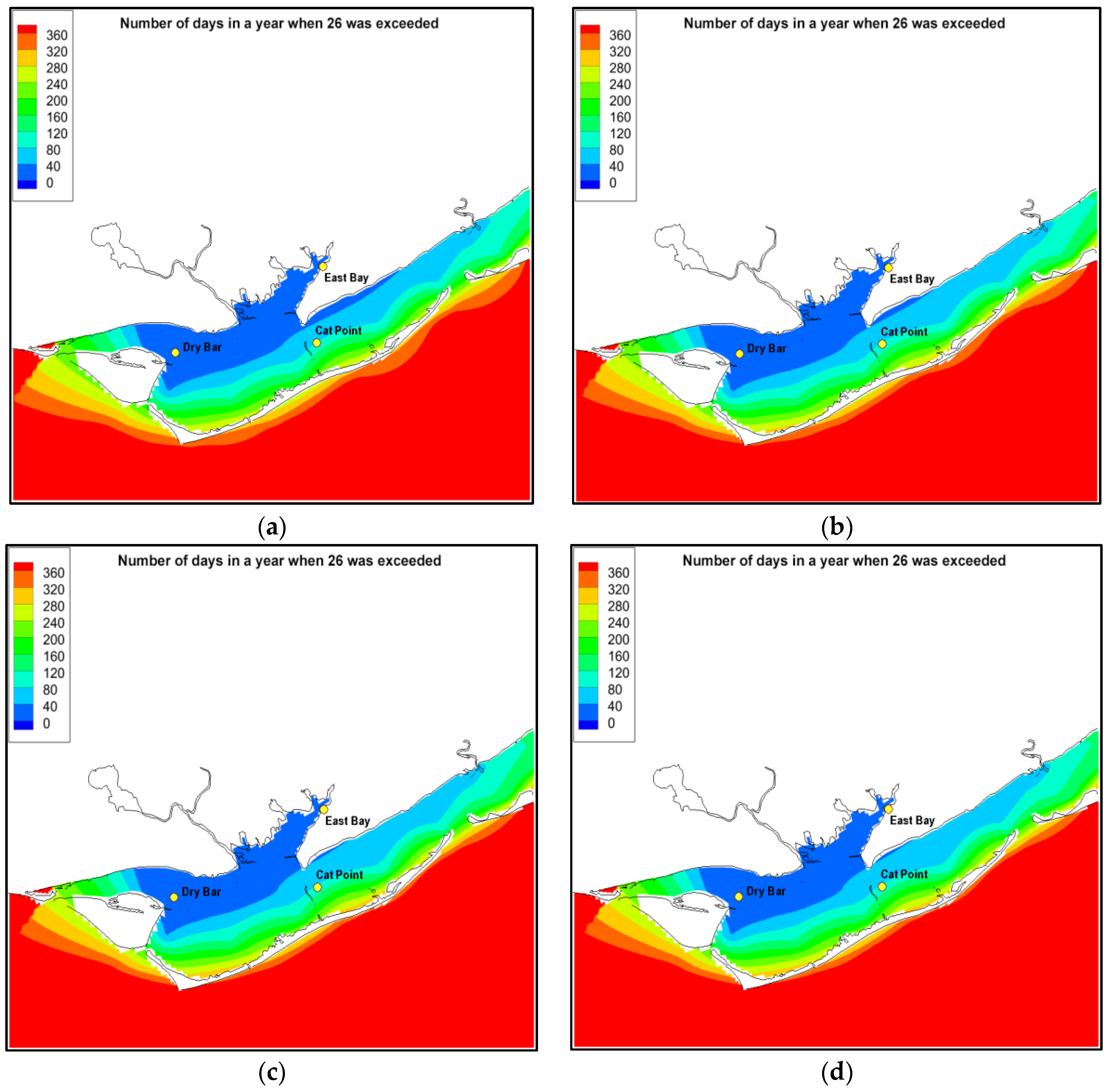

| Scenario | Mean | Mean (%) | Standard Deviation | Standard Deviation (%) | Minimum | Maximum |
|---|---|---|---|---|---|---|
| I | 519.2 | 0.00 | 411.4 | 0.00 | 124.6 | 4700.6 |
| II | 514.4 | 0.92 | 391.3 | 4.89 | 136.4 | 3965.7 |
| III | 515.9 | 0.64 | 391.4 | 4.86 | 136.4 | 3965.7 |
| IV | 516.4 | 0.54 | 391.0 | 4.96 | 136.4 | 3965.7 |
| Scenario | Flowrate Adjustment |
|---|---|
| V | 90% (−10%) |
| VI | 110% (+10%) |
| VII | 130% (+30%) |
| VIII | 150% (+50%) |
| IX | 200% (+100%) |
| X | 130% (+30%), when flow is over 15,000 cfs |
| Scenario | Mean | Minimum | Maximum |
|---|---|---|---|
| I | 519 | 124.6 | 4700.6 |
| V | 467 | 112.1 | 4230.5 |
| VI | 571 | 137.1 | 5170.7 |
| VII | 604 | 162.0 | 6110.8 |
| VIII | 778 | 186.9 | 7050.9 |
| IX | 1038 | 249.2 | 9401.2 |
| X | 1298 | 311.5 | 11,751.5 |
| Station | Root Mean Square Error | Correlation Coefficient |
|---|---|---|
| Cat Point | 1.3 ppt | 0.87 |
| Dry Bar | 1.6 ppt | 0.82 |
| East Bay | 2.4 ppt | 0.71 |
© 2016 by the authors; licensee MDPI, Basel, Switzerland. This article is an open access article distributed under the terms and conditions of the Creative Commons Attribution license ( http://creativecommons.org/licenses/by/4.0/).
Share and Cite
Paramygin, V.A.; Sheng, Y.P.; Davis, J.R.; Herrington, K. Simulating the Response of Estuarine Salinity to Natural and Anthropogenic Controls. J. Mar. Sci. Eng. 2016, 4, 76. https://doi.org/10.3390/jmse4040076
Paramygin VA, Sheng YP, Davis JR, Herrington K. Simulating the Response of Estuarine Salinity to Natural and Anthropogenic Controls. Journal of Marine Science and Engineering. 2016; 4(4):76. https://doi.org/10.3390/jmse4040076
Chicago/Turabian StyleParamygin, Vladimir A., Y. Peter Sheng, Justin R. Davis, and Karen Herrington. 2016. "Simulating the Response of Estuarine Salinity to Natural and Anthropogenic Controls" Journal of Marine Science and Engineering 4, no. 4: 76. https://doi.org/10.3390/jmse4040076






